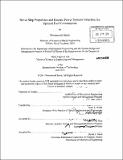| dc.contributor.advisor | Mark S. Welsh. | en_US |
| dc.contributor.author | Sarris, Emmanouil | en_US |
| dc.contributor.other | Massachusetts Institute of Technology. Engineering Systems Division. | en_US |
| dc.date.accessioned | 2012-01-13T18:44:42Z | |
| dc.date.available | 2012-01-13T18:44:42Z | |
| dc.date.copyright | 2011 | en_US |
| dc.date.issued | 2011 | en_US |
| dc.identifier.uri | http://hdl.handle.net/1721.1/68573 | |
| dc.description | Thesis (Nav. E.)--Massachusetts Institute of Technology, Dept. of Mechanical Engineering; and, (S.M. in Engineering and Management)--Massachusetts Institute of Technology, Engineering Systems Division, System Design and Management Program, 2011. | en_US |
| dc.description | Cataloged from PDF version of thesis. | en_US |
| dc.description | Includes bibliographical references (p. [100]-102). | en_US |
| dc.description.abstract | Although propulsion and electric power systems selection is an important part of naval ship design, respective decisions often have to be made without detailed ship knowledge (resistance, propulsors, etc.). Propulsion and electric power systems have always had to satisfy speed and ship-service power requirements. Nowadays, increasing fuel costs are moving such decisions towards more fuel-efficient solutions. Unlike commercial ships, naval ships operate in a variety of speeds and electric loads, making fuel consumption optimization challenging. This thesis develops a flexible decision support tool in Matlab® environment, which identifies the propulsion and ship-service power generation systems configuration that minimizes fuel consumption for any ship based on its operating profile. Mechanical-driven propulsion systems with or without propulsion derived ship-service power generation, separate ship-service systems and integrated power systems are analyzed. Modeling includes hull resistance using the Holtrop-Mennen method requiring only basic hull geometry information, propeller efficiencies using the Wageningen B series and transmission and prime movers fuel efficiencies. Propulsion and ship-service power generation systems configuration is optimized using the genetic algorithm. US Navy's Advanced Surface Ship Evaluation Tool (ASSET) model for the DDG-51 Flight I destroyer was used for modeling validation. Optimal fuel consumption results are compared against the existing configuration for the DDG-51 Flight I destroyer using a representative operating profile. | en_US |
| dc.description.statementofresponsibility | by Emmanouil Sarris. | en_US |
| dc.format.extent | 228 p. | en_US |
| dc.language.iso | eng | en_US |
| dc.publisher | Massachusetts Institute of Technology | en_US |
| dc.relation.requires | CDROM contains supplemental material (data and Excel files). | en_US |
| dc.rights | M.I.T. theses are protected by
copyright. They may be viewed from this source for any purpose, but
reproduction or distribution in any format is prohibited without written
permission. See provided URL for inquiries about permission. | en_US |
| dc.rights.uri | http://dspace.mit.edu/handle/1721.1/7582 | en_US |
| dc.subject | Mechanical Engineering. | en_US |
| dc.subject | Engineering Systems Division. | en_US |
| dc.title | Naval ship propulsion and electric power systems selection for optimal fuel consumption | en_US |
| dc.type | Thesis | en_US |
| dc.description.degree | S.M.in Engineering and Management | en_US |
| dc.description.degree | Nav.E. | en_US |
| dc.contributor.department | System Design and Management Program. | en_US |
| dc.contributor.department | Massachusetts Institute of Technology. Department of Mechanical Engineering | |
| dc.contributor.department | Massachusetts Institute of Technology. Engineering Systems Division | |
| dc.identifier.oclc | 767605371 | en_US |
